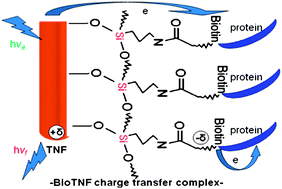The trititanate (H2Ti3O7) nanofibers (TNFs) prepared by a hydrothermal method, which are photocatalytically inactive, have been biotinylated by their reaction with N-hydroxysuccinimidobiotin through aminosilinization with 3-aminopropyl triethoxysilane (APTS). Surface morphology and covalent binding of the biotinylated TNFs (BioTNFs) are identified by XRD, SEM, TEM and FT-IR measurements. The BioTNFs are observed to form a charge transfer state as proved by XPS and the diffuse reflectance UV-visible absorption spectra, exhibiting stronger surface emission than free TNFs or TiO2 quantum dots. The strong fluorescence emission of BioTNFs is found to be significantly quenched upon interaction with streptavidin due to photoinduced electron transfer from the charge transfer state of the BioTNFs to streptavidin. On the other hand, the fluorescence of Cy3 was observed to be enhanced upon binding Cy3-streptavidin with BioTNFs, indicating that BioTNFs are good immobilizers of protein. These results suggest that BioTNFs are potent optical probe materials for protein analysis.

You have access to this article
 Please wait while we load your content...
Something went wrong. Try again?
Please wait while we load your content...
Something went wrong. Try again?


 Please wait while we load your content...
Please wait while we load your content...